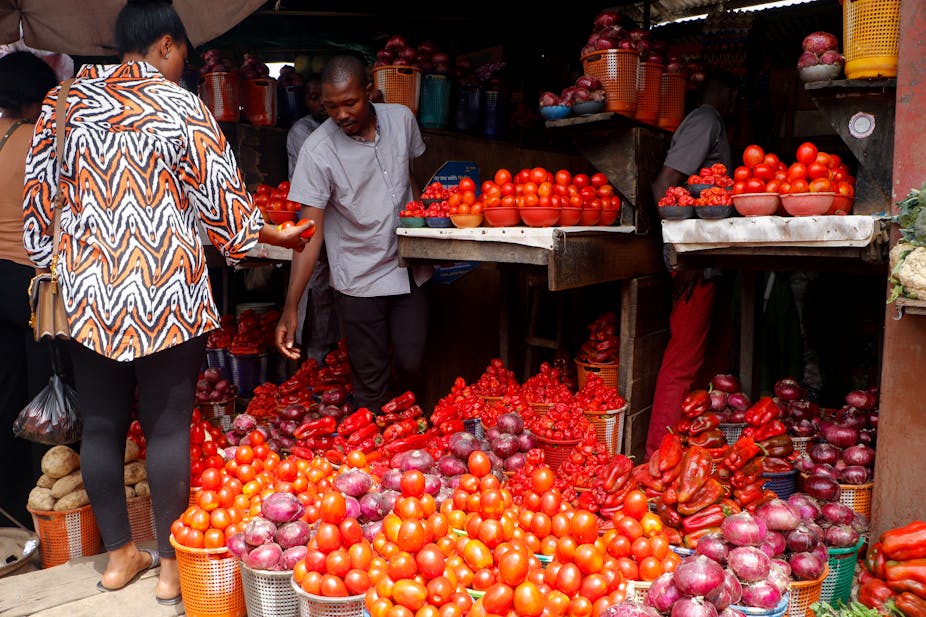Traders in Wuse, Abuja. Nigeria’s inflation is driven by soaring food costs and the fall of the country’s currency. Emmanuel Osodi/Anadolu via Getty Images
Just as Nigerians were gradually digging out from the devastating effects of the COVID-19 pandemic, they were hit by high inflation.
The Nigerian economy contracted by 6.1% at the peak of COVID in the second quarter of 2020. Unemployment rate rose from 27% in the second quarter of 2020 to 33% in the fourth quarter of the same year.
The World Bank estimated that 11 million Nigerians were pushed into poverty during the pandemic, in addition to the 100 million (out of 200 million people in the country) who were already classified as poor.
Now, Nigerians have to grapple with unprecedented inflation too.
Nigeria’s inflation rate rose to 29.90% in January 2024, from 28.92% in December 2023. This is the highest it has been in two decades.
Global inflation has reached historic levels during the past three years. The International Monetary Fund expects global inflation to fall, however, from 8.7% in 2022 to 6.8% in 2023 and 5.2% in 2024.
The US and the EU have seen inflation decline during the past few months, prompting central banks to pause interest rate hikes.
In fact, central banks in developed countries are expected to begin reducing interest rates this year.
So why is inflation rising in Nigeria while it has been declining in other parts of the world?
As a development economist who has been studying the Nigerian economy for over four decades, I argue in this article that the factors that are pushing inflation downward in other parts of the world are moving in the opposite direction in Nigeria.
I also suggest that no single factor can adequately explain rising inflation and escalating food costs in Nigeria. Nigeria’s unprecedented inflation is a case of multiple factors interacting to trigger cost-push inflation.
If not addressed urgently, Nigeria’s rising inflation could result in “stagflation”. This is when the lack of robust economic growth is combined with hyperinflation.
With high numbers of unemployed people who must purchase basic necessities at very high prices, Nigeria risks widespread protests, social tensions and political instability.
Fuel prices
Declining oil prices, caused by a slow post-pandemic economic recovery, are causing freight prices to fall, which in turn has lowered production costs and consumer prices in many countries.
But Nigerians are not benefiting from the global decline in oil and natural gas prices. Rather, they are paying substantially more at the pump because of the removal of fuel subsidies.
Fuel prices soared, from N557 (US$0.35) to N617 (US$0.39) per litre, after the removal of the subsidy in May 2023.
In other words, while falling oil and natural gas prices are reducing production costs in other countries, costs are rising in Nigeria.
A World Bank study found that complete removal of fuel subsidies, except kerosene subsidies, increases economy-wide prices by 3.4%.
Supply constraints and inflation
Another factor that is causing global inflation to decline is the easing of pandemic-era supply chain bottlenecks, which has occurred faster than expected.
Nigeria, however, continues to endure supply constraints because of the floating of the local currency, the naira. Floating the naira means its value will from now on be determined by market forces of demand and supply, or what the Central Bank of Nigeria refers to as “the willing seller, willing buyer” exchange rate.
The central bank previously adopted a “managed floating” policy, whereby it periodically adjusted the official exchange rate. But the adjustment criteria were considered to be too opaque and un-reflective of market fundamentals.
The naira depreciated by 69% between June 2023 when the foreign exchange market was liberalised and the middle of February 2024.
Currency depreciation has increased import costs. Nigeria is an import-dependent economy, and Nigerian importers are purchasing goods at prices that are already very high abroad. The costs of these goods have also gone up because of higher tariffs caused by the depreciation of the naira.
For instance, only 1% of the roughly six million metric tonnes of wheat that Nigeria consumes annually is produced domestically. The war in Ukraine has raised food prices in Nigeria, as the country imports wheat from Russia and Ukraine, in addition to fertilizers from Russia.
Thus, much of Nigeria’s inflation is caused by a combination of oil subsidy removal and devaluation of the naira. Making it worse are longstanding supply constraints like instability in food-producing areas of the country, deteriorating rural infrastructure, climate change and the exodus of rural dwellers to urban centres in search of opportunities.
Food inflation in Nigeria also reflects low productivity in the agricultural sector. Output has failed to keep up with population growth. Nigeria’s population has been growing by about 2.4% a year, while the growth of agricultural value added is a paltry 1.8%.
Uncertain inflationary outlook
Inflation is cooling globally partly because of the restrictive monetary and fiscal policies of many countries across the world. Central banks hiked interest rates aggressively and many governments cut spending.
Nigeria’s Central Bank governor Olayemi Cardoso expects Nigeria’s inflation rate to decline to 21.4% in 2024, following interest rate increases and rising agricultural productivity.
But I don’t expect a steep fall in Nigerian’s inflation this year.
First, inflation-targeting policies have lagged effects, and usually take time to make a difference to consumer prices.
Second, many prices are typically “sticky” downward. Once they go up they don’t come down – or only very gradually.
Lastly, Nigeria’s inflation targeting policy can only be effective if it is coupled with fiscal discipline by the executive and legislative branches of government. There is no evidence this has been the case so far under the Bola Tinubu administration.![]()
Stephen Onyeiwu, Professor of Economics & Business, Allegheny College
This article is republished from The Conversation under a Creative Commons license. Read the original article.


